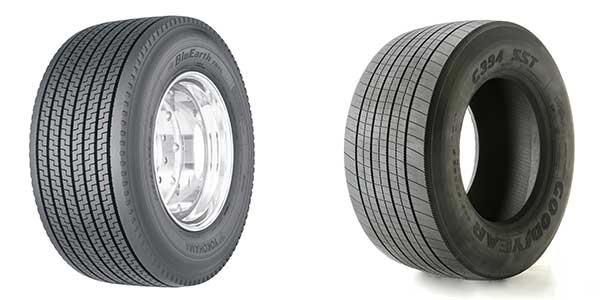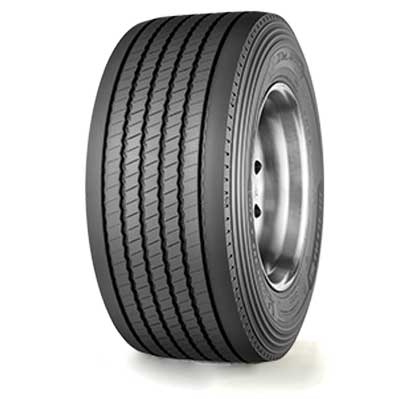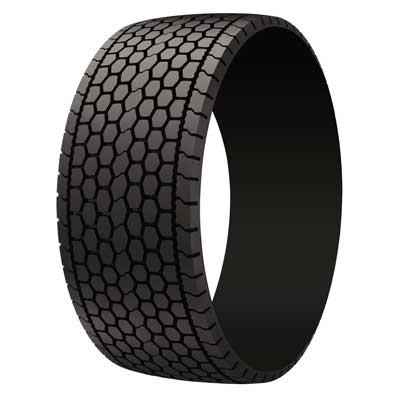
Adoption of wide base tires has continued to increase in the years since their entrance into the market in 2000. Still, they make up a relative minority of the market, and many fleet managers may still have questions about whether wide base tires are right for their fleet. So with that in mind, let’s tackle four of the biggest questions surrounding wide base tires.
1. Who should use wide base tires?
The three main reasons a fleet might choose wide base tires are weight savings, fuel efficiency, and load efficiency. Wide base tires are more expensive, however, so the trade-off needs to be worth it.
Wide base tires intended for the over-the-road line-haul market will save significant amounts of fuel when compared to tires that are not designed for low rolling resistance, according to a recent Confidence Report by the North American Council for Freight Efficiency (NACFE). Of course, exact fuel savings depends on application and other equipment. The report also found that wide base tires generally display lower rolling resistance when compared to equivalent dual tires, as well as up to a 1% reduction in overall vehicle weight—no easy feat.
As with all truck equipment choices, it all comes down to application. Most of the tire experts Fleet Equipment surveyed agreed that wide base tires are best for weight-sensitive applications, including fuel haulers, bulk haulers, long-haul trucks, cement mixers and tanker trucks.
“The revenue has to overcome the tire cost,” says Rick Majewski, a Marangoni tire dealer at Wilson County Tire in Tennessee. “If you take a gasoline hauler and put a wide base on, you can get a couple hundred more gallons of fuel, which equals revenue. Say it’s $2 a gallon for every load they haul—that’s another $400. Usually fuel tankers run around the clock, 24 hours, so they might get six loads a day and that would be $2,400 a day in extra revenue. In other applications, the cost is too much for it to be worth it.”
“Fleets carrying commodities that are heavy will have a higher concentration of wide base tires,” says Bianca Hogan, the U.S. country marketing manager for Michelin Americas Truck Tires. “The higher the mileage and the more weight sensitive, the more likely a wide base tire will benefit the operation.”
“Fuel/liquid bulk tankers, dirt/material haulers, and waste industries are becoming one of the fastest-growing applications for these products,” Tom Clauer, Yokohama Tire’s corporate manager of commercial and OTR product planning, says of wide base tires. “Yokohama offers a full line of ultra wide base products to address the specific needs of these applications.
“Long haul, over-the-road applications have struggled in past years due to the lack of availability in over-the-road situations,” he continues. “With an increased adoption rate for these tires, such as the Yokohama BluEarth 709L, the increased market penetration has led to an increase in over-the-road availability. The result has been a slow, but steady growth trend.”
That provides us with a nice segue into question two…
2. How many fleets spec wide base tires?

“To date, ultra wide base tires represent a small segment of the market—fewer than 5%,” says Matt Schnedler, senior product manager of truck, bus and retread for Bridgestone Americas Tire Operations. “We see that holding steady over the next few years, particularly given the specialized use we see most often around this unique tire application.”
Growth was steady and continuous in the decade after the introduction of wide base tires to the market, but the tires appear to have hit a plateau in terms of how many fleets they make sense for.
The adoption rate of wide base tires has remained relatively consistent, according to Hankook Tire. Typically, fleets do not carry both wide base tires and dual tires as it’s difficult to manage both. In the future, Hankook expects more fleets to look into the adoption of wide base tires, due to the benefits of lower rolling resistance and better mileage. Compared to dual tire set ups, wide base tires have half as many sidewalls, which in turn can reduce the rolling resistance by up to 33%, Hankook said.
“Both tractor and trailer OEMs now accept [wide base tires] and offer them in most of their product lines, which has led to growth in the replacement market,” Clauer, of Yokohama, says. “As technologies continue to improve and regulations tighten, we anticipate this growth to continue well into the future.”
“Over the past several years, dual-wheel setups have virtually eliminated the rolling resistance advantage that wide base tires once provided,” says Brian Buckham, general manager of product marketing for Goodyear. “However, we believe that wide base tires will continue to gain acceptance among fleets that can benefit from their weight-saving properties. This can add up to approximately 1,100 lbs. saved per tractor-trailer combination when using aluminum wheels.”
Michelin’s Hogan describes the adoption rate of the company’s X One wide base tires as “significant,” adding that the company expects the adoption rate to continue to climb in the future.
3. What kind of ROI can a fleet expect?
Those polled said that the largest value proposition of wide base tires is lower rolling resistance and better fuel economy.
“One of most important factors in realizing an ROI is to perform proper maintenance. Ultra wide base tires can actually be easier to maintain given the ease of access to the tire without having to address the cumbersome location of the inside dual position,” Yokohama’s Clauer says. “Proper maintenance can lead to improved fuel efficiencies, especially in long haul situations.”
Yokohama’s wide base offerings, according to Clauer, include the 902L, TY517 and the BluEarth 709L, which is available to both equipment manufacturers and replacement buyers.
“The best way for fleets to determine which tire will be the right choice for their fleet is to evaluate their ‘success factors,’” Michelin’s Hogan says. “Fleets need to understand the intended use of their vehicles and their operational needs. The fleet operator should prioritize the key success factors for the operation, including wear, fuel costs, mileage, traction, vehicle weight, payload weight, etc.
“The Michelin X One tire has provided for several million tons of added freight. Fleets that switched to X One tires have experienced up to a 10% improvement in fuel efficiency and more than 740 lbs. of weight savings per truck. Tractor and trailer configurations outfitted with Michelin X One tires can save between 6-10% in fuel due to the weight savings of wide base singles [or 1400 lbs.] thus generating more revenue. This increased payload translates to a reduced number of trips and greater profitability for the fleet,” Hogan concludes.
Goodyear’s Buckham brings up self-sealing capability as another benefit. “Goodyear offers two wide-base tire lines that contain its DuraSeal Technology: the G392 SSD DuraSeal + Fuel Max and the G394 SST DuraSeal + Fuel Max,” he says. “Built into the tire during the manufacturing process, DuraSeal Technology instantly seals nail-hole punctures of up to ¼-in. in diameter in the repairable area of the tire’s tread.
4. What’s different about retreading wide base tires?

Retreading is an excellent way for fleets to recoup the value of a tire casing, and wide base tires are no exception. Retreading is far less expensive than purchasing a new tire, and as long as the casing is in sufficiently good shape, can often run as long as a new tire.
However, wide base tires are designed to carry heavier loads, and as such, they generate heat differently than a typical TBR tire or retread, as Bridgestone’s Schnedler points out. While wide base tires can be retreaded, the rate of retreading is not as high as standard TBR tires.
The casing is an asset to the fleet, and anytime you can retread that casing, you are saving money. According to Hankook Tire, there is not much of a difference between the process of retreading a traditional tire compared to retreading a wide base tire, although the wide base retreads do represent a smaller market.”
“The wide base retread is generally 50% less expensive than a premium new wide base tire and normally will run as long if not longer than a new tire provided the casing has been well maintained,” says Ron Elliott, the marketing and communications manager for Marangoni Tread North America. “One of the issues that we see with wide base tires is the lack of proper air inflation while the tire is new thus potentially leading to exposed belt edges during the buffing process, which renders the casing useless.
“If the casing has been well maintained and is suitable for retreading, then the Ringtread is the best option,” Elliott continues. “Ringtread is a splice-less double contoured precured tread that runs cooler than traditional spliced tread. When you retread a tire with spliced tread you create a heavy spot where the two ends meet, and this heavy spot generates additional heat each time it makes contact with the road service.
“Wide base tires typically run hotter than conventional duals, so proper air pressure and no heavy spots due to a splice will serve to help preserve the casing,” he adds.
“It is important for retread performance to match new tire performance,” Goodyear’s Buckham stresses. “Because wide base tires operate closer to their load capacity compared to dual tires, having the highest-quality retread, based on a premium casing, is a top priority.”
“Each fleet has its specific requirements of what it is looking for in a retread,” Michelin’s Hogan says. “It depends on the fleet’s type of operation, casing management, turnaround time, availability of the necessary product, level of dealer service, on-line reporting needs, and fleet location. In the long run, retreads offer excellent mobility solutions that can lead to cost savings and environmental benefits.”













